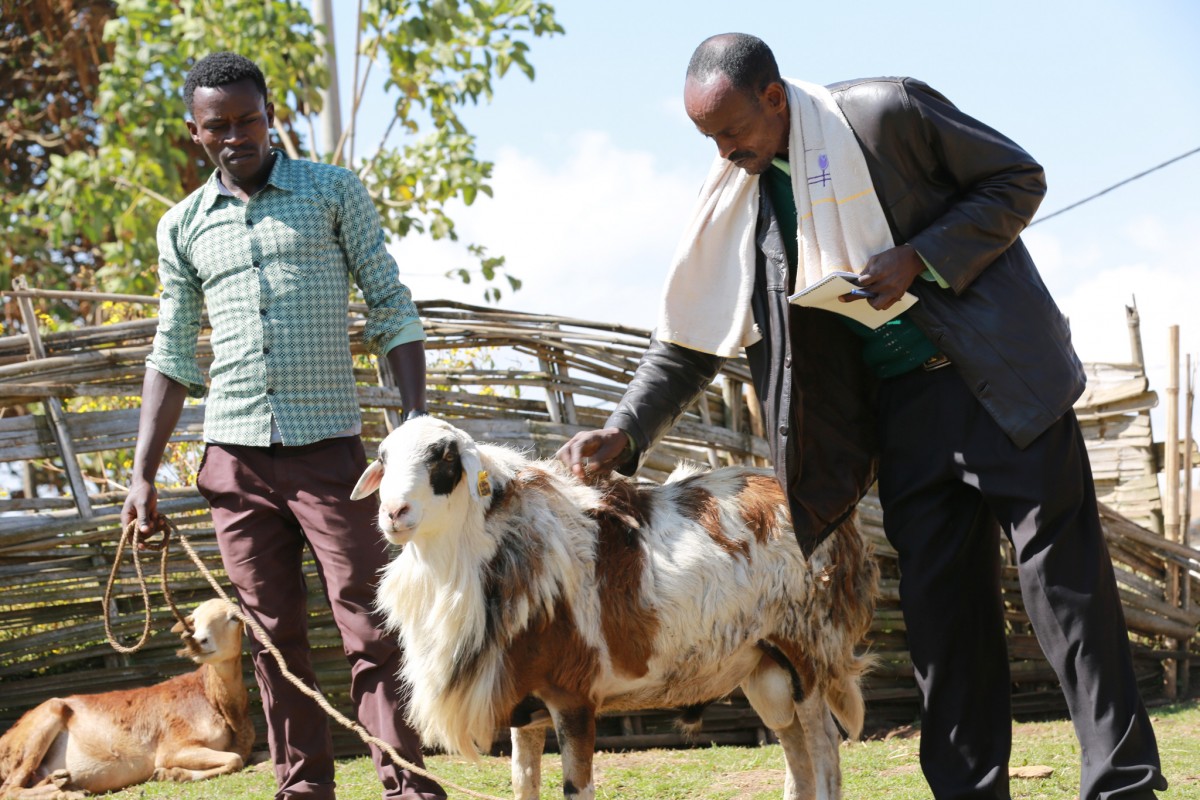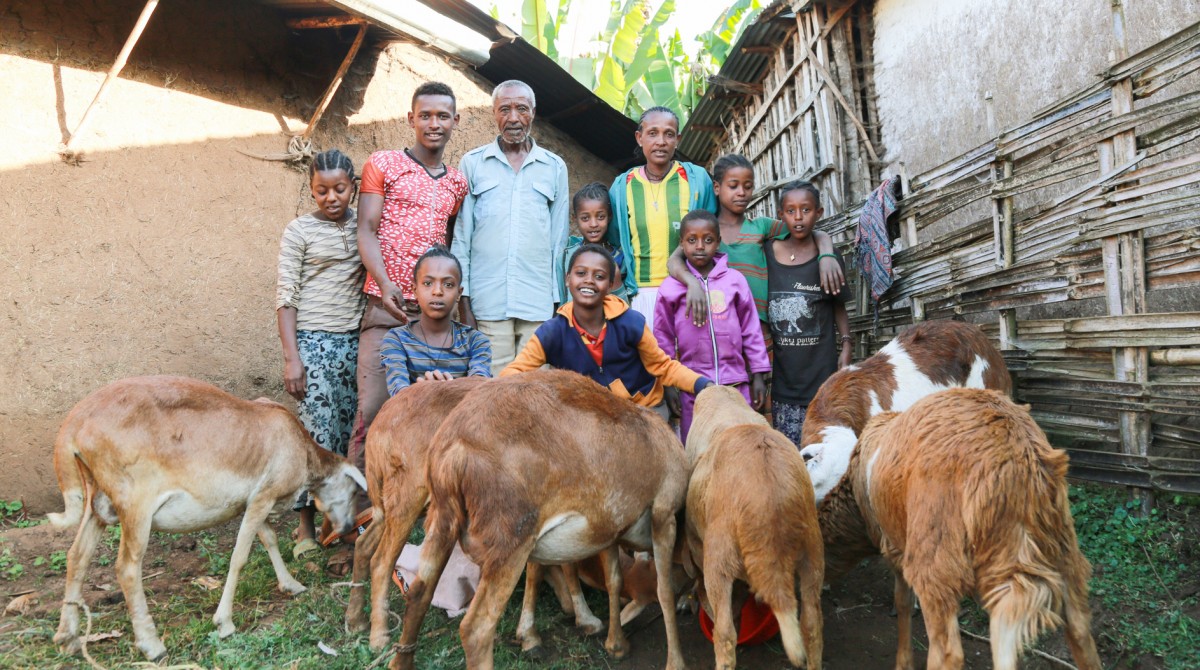High up in the misty mountains of southwest Ethiopia sits a small town called Bonga. Known around the globe as the birthplace of wild Arabica coffee, it’s also got another claim to fame – its sheep are considered the biggest and the best in the country, earning farmers a decent income and inspiring them to re-invest their wealth to assist local construction of roads, a meeting hall and a dam.
Bonga’s successes are thanks to a sheep breeding program that teaches and empowers Ethiopian livestock farmers to make evidence-based breeding decisions to improve the productivity of their flocks.
“Our newborn lambs have doubled in weight. We used to sell a sheep for ETB 1200 -1300 (US $40-43). Now we get between ETB 3800-6700 (US $126-226). It’s a big improvement so we have a responsibility to share the benefits with our fellow villagers and future generations,” says Alemayehu Haile, chair of the village’s sheep breeder cooperative, which oversees the day-to-day operation of the breeding program.

The first Bonga cooperative (Boka-shuta) was set up in 2009 with 120 households keeping 1200 sheep as part of the Community-Based Breeding Program, which assists farmers to pool their flocks to create a larger gene pool from which breeding animals can be selected, employs local community members to monitor how well individual animals perform, and provides scientific information to farmers on different breeding options.
“The main difference with community-based breeding is that the community controls it. This is the way that traditional farmers have been doing for centuries before modern breeding programs tried to centralize control,” says Aynalem Haile, a scientist specializing in small ruminant breeding with the International Center for Agricultural Research in the Dry Areas (ICARDA), which leads the program in partnership with the International Livestock Research Institute (ILRI), Austria’s University of Natural Resources and Life Sciences (BOKU), and the Ethiopian National Agricultural Research System.
What makes Bonga different
One of the program’s first steps was to spend time understanding the community’s livestock management process. They found that five or six households would share their rams for breeding.
“The challenge with this structure is that you start to get some inbreeding because there isn’t enough genetic diversity in such a small group of rams,” says Aynalem.
“We encouraged them to instead think about establishing a sharing mechanism where 60 households can share rams in rotation. This means that while rams would still be communally used in the smaller group of 5 or 6 households, after a year or so, they would be rotated amongst the 60 households. From this, the idea for a cooperative grew.”
After establishing a clear management structure and getting the legal paperwork in order, the cooperative met regularly to make decisions about which rams to breed, which rams to sell, how to manage rams, and how to fatten and sell unselected rams, based on data provided by national researchers and enumerators.
“We have also developed the first genetic digital database which has helped us to more quickly and accurately provide the breeder cooperative with the information they need to make their selection decisions,” says Tesfaye Getachew, a researcher with ICARDA.
The breeding program went on to achieve astounding results - farmer incomes increased by an average of 20%, breeding rams were frequently sent to other regions of Ethiopia for breeding, and the village saw improvements in household resilience and community cohesiveness.

“Before the breeding program, we didn’t know how to choose better sheep for breeding. Now we have got better animals and are benefitting more and more,” says farmer Alemitu Shigato.
“I have six kids. When they get sick I can take them to hospital. I buy them school materials and buy them clothes as well. I am also able to pay tax.”
There are a few factors that have made the community-based breeding program a particular success in Bonga. One is the availability of feed.
“Bonga receives annual rainfall of more than 2000 mm and it is located in a part of Ethiopia that is known for its forest cover. The land is fertile and therefore feed is available in abundance in the area. Unlike most of our program sites where feed is a major problem, in Bonga that is not the case,” Aynalem says.
Another major factor has been the commitment of the researchers, cooperative and regional government.
“The south regional government was really keen on community-based breeding and made investments that enabled local enumerators to be paid good salaries. This means they collected very good data and took care to provide good advice to the cooperatives. A little investment like this makes a huge difference to the communities,” Aynalem says.
Self-sustaining private sector
The Boka-shuta cooperative has steadily increased its membership base, now at 338 members and it currently holds Birr 3.34 million (US$96,500) in capital. So far, the community has shared Birr 1.36 million (US$39,800) in dividends and spent Birr 377,500 (US$10,700) on community infrastructure projects.
“The cooperative contributed to the construction of a local road in the village, they built a big meeting hall which is used by farmers in the village and neighboring community, they bought bonds to support the construction of the Grand Ethiopian Renaissance Dam, and they bought 50 chairs for the village administration,” Aynalem says.
As the Community-Based Breeding Programs expand across Bonga thanks to investments from the government and private donors, many communities have started following the lead of the Boka-shuta cooperative.
“We now have 15 breeding cooperatives across Bonga, some of which are also starting to invest their dividends back into the community," Tesfaye says.
"The cooperative structure will serve the community well into the future. Bonga has a very well-organized and vibrant cooperative that thinks out of the box. They have overseen a transformation from subsistence farming to a market-oriented sheep production system. They are becoming a self-sustaining private sector.”
Alemayehu takes an even longer-term view.
“We are teaching future generations what can be achieved through hard work and commitment,” he says.
